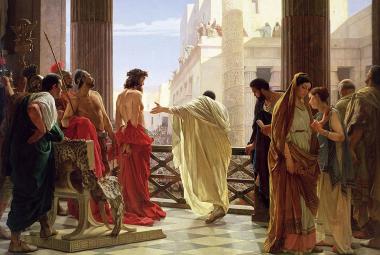Here is a book of the Bible which is among the least studied and the most emotionally controversial. It's a book with only 117 verses and 470 Hebrew words,1 yet it is among the most difficult and mysterious books in the entire Bible. It's a book about lovemaking from an author who had 700 wives and 300 concubines (women who took his heart away from the Lord).2
A cursory glance at the Song's history of interpretation reveals a diversity of opinion unequaled in the study of any other Biblical work. The Song has been interpreted as: (a) an allegory, (b) an extended type, (c) a drama involving either two (or three) main characters, (d) a collection of Syrian wedding songs, (e) a collection of pagan fertility cult liturgies, and (f) an anthology of disconnected songs extolling human love.
S. Craig Glickman quotes a volume written on the history of the Song of Songs during the Middle Ages:
Over five hundred commentaries on the song remain with us from the first seventeen hundred years alone. Yet after these five hundred and perhaps more, the Westminister Assembly observed in 1657 that the commentaries customarily increased the cloud of obscurity they had hoped to remove.3
Scholars differ widely on the structure of the Song, its unity or lack of it, the nature of its metaphors, and the nature of the love extolled by the Song. Probably no other book of the Bible has such a variegated tapestry of interpretation. Many evangelical scholars interpret the Song of Songs as a lyric poem, which has both unity and logical progression. The major sections of the Song deal with courtship (1:2-3:5), a wedding (3:6-5:1), and maturation in marriage (5:2-8:4). The Song concludes with a climactic statement about the nature of love (8:5-7) and an epilogue explaining how the love of the couple in the Song began (8:8-14).
There are those who feel that this lyric poem deals only with the subject of Biblical lovemaking, and a number of books focus on this aspect. 4 The love relationship between a man and a woman - the courtship, the wedding night, and the subsequent sexual adjustments of the young couple - are all fruitfully treated. So explicit are these aspects that because of its erotic content, the rabbis forbade the book to be read by anyone under the age of 30. Indeed, of all the many books on marriage that are available in Christian and secular bookstores, none of them can possibly improve on the Biblical teaching found in this Song of Songs. Here is romantic love for married couples that exceeds our greatest dreams and expectations. Here is a manual on sex that beats all secular viewpoints on how a man and a woman should make love.
There is no way to escape the fact that this book is quite sensual. Glickman summarized it this way:
Sensuous love with erotic overtones is God's intent for the marriage relationship. The distortion of that relationship has no doubt abased this dimension of life, but that does not justify placing such experience - or Scripture's Song about it - into the inactive file of living.5
The secular world has drowned us with its encouragements toward illicit affairs, easy divorce, the glories of promiscuity and joys of adulterous relationships. While critical of Christian viewpoints, it has done nothing to improve our marriages or satisfy the longings of our hearts. The exploitation of sex - and the disavowal of marriage and the family itself in our culture - has sown the wind and we now are reaping the whirlwind.
Is it Inspired?
Rabbi Akiba, the leading rabbi of the Bar Kochba revolt (132-135 A.D.) is quoted in the Mishnah:
In the entire world there is nothing to equal the day on which the Song of Songs was given to Israel. All the writings are holy, but the Song of Songs is most Holy.6
(Due to his support, all questions about the place of the Song of Songs in the canon of the Scriptures were silenced.)
This book is inspired; it was part of the Scriptures when Jesus Christ was here on the earth. He put His imprimatur on the entire volume when He said, "The Scripture cannot be broken." (John 10:35). Some say that it is not quoted in the New Testament, yet there are fragments everywhere. 7 It is an extremely difficult book to teach because it is so personal. It needs to be. And like a diamond, it has many facets, and each one reveals a unique beauty.
King Solomon
As Israel's third king, Solomon ruled from 971 to 931 B.C. Solomon was perhaps more gifted with literary skill than any other king of Israel for he wrote 3,000 proverbs and 1,005 songs.8 It is appropriate that a subject as wonderful as romantic love is described in sublime language by a competent human author, writing of course under the Holy Spirit's inspiration. Interestingly, of the more than 1,000 songs Solomon wrote, only this one was designed by God to be included in the Biblical canon. What is the historical narrative underlying the opera?
Two, or a Triangle?
A key factor, even among those who take the text quite literally, is whether there are two or three characters in the book. Over 100 years ago, Ewald, the great German critic - who has been called the father of "higher" criticism - suggested a triangular view: a young shepherdess, in love with a shepherd, who was abducted by King Solomon. He vainly attempted to woo her away from her lover and eventually set her free to return to him.
This view has been accepted among some scholars, but it would lower the role of Solomon in the piece. Also, this view would dismiss some of the most lovely and tender passages of this little book as mere seduction instead of sincere and holy love. Cynicism would thus replace the very passages that have thrilled readers through the centuries. It reduces the erotic scenes to premarital lust rather than the beauty of sexual relations within marriage.
The Story Behind the Opera
In the mountain district of Ephraim, King Solomon had a vineyard, 9 and he let it out to an Ephraimite family as keepers. The husband and father were apparently passed away, but there was a mother and at least two sons and two daughters. The older daughter, called the Shulamite,10 is the "Cinderella" of the piece. Her brothers did not appreciate her and foisted hard tasks upon her. She had no opportunity to look after herself. She's sunburned but naturally comely. One day she encounters a handsome stranger-shepherd, who views her as without blemish. Friendship ripens to affection, and finally, love. He promises to return and make her his bride. Her brothers, skeptical, regard her as being deceived by this stranger. He is gone a long time. She would dream of him in the darkness; she trusted him. Finally, a glorious cavalcade arrives, and the attendants announce, "The King has sent for you." In obedience, she responds. When she looks into the face of the King, behold the King was the very shepherd who had won her heart: "I am my beloved's, and his desire is toward me."
This appears consistent to the Biblical presentation - from Genesis to Revelation - of the Shepherd who came from heaven's highest glory down to this dark world that He might woo and win a bride for Himself. He went away, but He said, "I will come again, and receive you unto Myself."
Abishag's Role?
Some suspect that Abishag is in view here. Abishag was a beautiful young woman who spent her youth working in the fields and vineyards who was selected to lie beside the elderly King David and serve his needs during his dying years. She came from an area called Shunam, presumably in the Galilee. (The text is clear that her virginity was not taken away by the elderly King David.11 Her ministry to him was completely a matter of physical care, not sexual pleasure.) Solomon, part of the household at that time, became deeply attached to her. When his brother Adonijah tried to get his mother's approval for taking Abishag to wife (since he lost the kingdom to Solomon), Solomon was enraged and had Benaiah his executioner kill Adonijah.12 Abishag was not a lady of the courts. She worked in the fields under the hot sun and was not used to expensive clothes and the exotics of the nobility. But she was also a natural beauty (like my Nan!).
This book is intended to improve dying or empty, boring marriages; to increase your love for your spouse; and, to illuminate true sexual and romantic understanding...but there's more.
Allegorical Views
Jewish tradition (the Mishnah, the Talmud, and the Targum) viewed the book as an allegorical picture of the love of God for Israel. 13 Church leaders, including Hyppolytus, Origen, and Jerome, have viewed the book as an allegory of Christ's love for His bride, the Church. 14 John the Baptist, the last of the Old Testament prophets, recognized Christ as the Bridegroom,15 as Christ Himself also claimed.16 Paul goes even further. 17 It is interesting that God always seems to use the marriage as the idiom of intimacy with Himself, from Adam's love for Eve, Boaz's role in taking Ruth as a Gentile bride, Hosea's taking unfaithful Gomer, et al. (It is also interesting that in each "type" of Gentile bride in the Scripture, there is never any death recorded.)18 It is also significant that in this most intimate of books, there are lessons that go far beyond the art of lovemaking itself!
Notes:
- Forty-seven of which appear only in this book.
- 1 Kings 11:1-4.
- S. Craig Glickman, A Song for Lovers , p.173.
- Fruchtenbaum, Hocking, et al.
- Glickman, A Song for Lovers , p.9
- Mishnah Yadaim 3:5.
- "The well of living water" (Jn 4); "the veiled woman" (1 Cor 11); "the precious fruit" (Jas 5:7); "the spotless bride" (Eph 5:27); "unquenchable love" (1 Cor 13:8); "love strong as death" (Jn 15:13); "ointment poured forth" (Jn 12:3); "draw me" (Jn 6:44); "the Shepherd leading His flock" (Jn 10:4, 5, 27); "fruits of righteousness" (Phil 1:11).
- 1 Kings 4:32.
- Song of Songs 8:11.
- Shulamite in Hebrew is merely the feminine form of the masculine name of Solomon. The story is of "Mr. and Mrs. Solomon."
- 1 Kings 1:4.
- 1 Kings 2:21-25.
- Israel is, indeed, portrayed as the "wife" of Yaweh in Hosea, Ezekiel, et al. Cf. Isa 49:18; 61:10; 62:5; Joel 2:16.
- So H.A. Ironside, Hudson Taylor, et al.
- John 3:29.
- Matthew 9:15.
- Ephesians 5:22-32.
- Tamar (Canaanite); Rahab (Amorite); Ruth (Moabite); Bathsheba (Hittite); Asenath (Egyptian).






